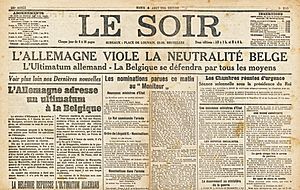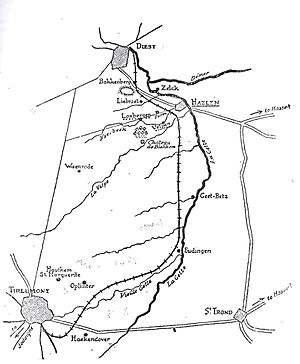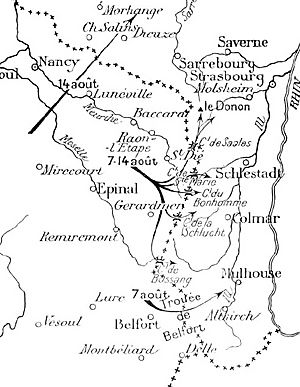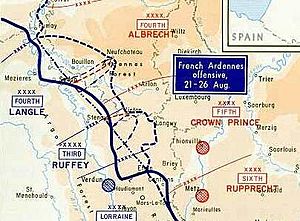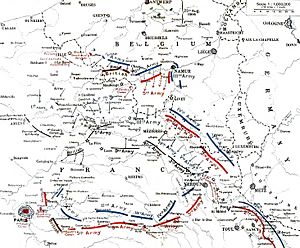Battle of the Frontiers facts for kids
Quick facts for kids Battle of the Frontiers |
|||||||
|---|---|---|---|---|---|---|---|
| Part of the Western Front of the First World War | |||||||
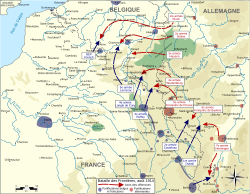 Map of operations on the frontiers |
|||||||
|
|||||||
| Belligerents | |||||||
| Commanders and leaders | |||||||
| Strength | |||||||
| Casualties and losses | |||||||
The Battle of the Frontiers was a series of battles fought at the start of the First World War in August 1914. These fights happened along the eastern border of France and in southern Belgium. Both France and Germany had their own plans for how to start the war. France had Plan XVII, which focused on attacking. Germany had a plan to sweep through Belgium and attack France from behind.
The German army moved very quickly. But they were slowed down by the French Fifth Army and the British Expeditionary Force (BEF). Even though the French and British were pushed back, their actions bought time. This allowed France to move troops to defend Paris. This led to the famous First Battle of the Marne.
Contents
How the War Started
Belgian Army Plans
Before the war, Belgium hoped other countries would help if they were invaded. They didn't have a strong alliance with France or Britain. Belgium's army was planned to gather in the middle of the country. This would help them delay any invader. They also had strong forts at Liège and Namur to protect their borders.
German War Plans
Alfred von Schlieffen was a German military leader. He made plans for a big battle against France. His idea was to attack France by going through Belgium. This would help them get around French defenses.
Later, Helmuth von Moltke the Younger took over. He changed the plan. He believed Germany would fight a war on two fronts (against France and Russia). Moltke's plan was still to attack France through Belgium. But he had fewer troops than Schlieffen thought were needed. This made the plan riskier. The goal was to surround the French armies and win quickly.
French War Plans
France had its own plan called Plan XVII. This plan involved five large armies. They would gather near the German border. France had more railway lines to the border than Germany. This meant they could wait to see what Germany would do.
The French expected Germany to attack through Lorraine or southern Belgium. They thought Germany would not send many troops through northern Belgium. This was a key mistake in their planning. The French also had some plans to work with the British army.
War is Declared
- On July 31, 1914, Germany warned Russia.
- On August 1, Germany declared war on Russia. France ordered its army to get ready.
- On August 2, German troops entered Luxembourg. Germany demanded to cross Belgium freely.
- On August 3, Belgium said no to Germany. Britain promised to help Belgium if Germany invaded. Germany then declared war on France.
- On August 4, Britain sent a warning to Germany. Germany invaded Belgium and attacked Liège. Britain declared war on Germany at midnight.
Preparing for Battle
French Army Gets Ready
Joseph Joffre was the French army's commander. He was given full control of the war. On August 2, German soldiers crossed into France. Joffre wanted to attack Alsace-Lorraine to help their ally, Russia.
Joffre also had to decide where to place his armies. He knew a big German attack might come through Belgium. He moved the French Fifth Army north to meet this threat. This was a difficult decision. It stretched the French lines very thin. Joffre also started removing commanders who weren't performing well. He met with the British commander, Sir John French. The British army would be ready by August 24.
French Battle Plan
Joffre's main goal was to destroy the German army, not just capture land. He planned to attack Alsace and Lorraine first. This would keep German troops busy there. Then, the main French attack would happen further north. This attack would try to break through the German center.
French leaders thought the German center would be weak. They believed most German forces were in Luxembourg and near Metz. But their intelligence was wrong. The Germans had many more troops in Belgium than the French expected. This would lead to big problems for the French.
Battles on the Borders
Battle for Mulhouse
The first French attack of the war happened on August 7. It was called the Battle of Mulhouse. French troops quickly captured the town of Altkirch. On August 8, they took Mulhouse after the Germans left. But the Germans soon counter-attacked. They recaptured Mulhouse on August 10. The French had to pull back.
Joffre then put General Paul Pau in charge of a new "Army of Alsace." This army attacked again on August 14. They pushed the Germans back and recaptured Mulhouse on August 19. The French even chased the Germans across the Rhine river. But this success didn't last. News of defeats elsewhere forced the French to pull back from Mulhouse again.
Battle of Haelen
The Battle of Haelen was a cavalry battle in Belgium on August 12. It happened near a river crossing. Belgian engineers tried to blow up the bridge, but it only partly collapsed. German cavalry tried to cross and attack.
The Belgians, led by Léon de Witte, fought on foot. They used their rifles to stop the German horsemen. The Germans suffered many losses and had to retreat. This was a Belgian victory. But it didn't stop the main German advance. The Germans soon surrounded and captured important Belgian forts.
Battle of Lorraine
The main French attack in Lorraine began on August 14. The French First and Second armies advanced. They faced the German 6th and 7th armies. The French quickly captured some areas. But the Germans had long-range artillery. They could fire on the French from far away.
On August 20, the Germans launched a big counter-attack. They pushed the French armies back. The French suffered heavy losses and had to retreat in a hurry. But they managed to regroup. By early September, they had fought back and regained some of the lost ground.
Battle of the Ardennes
Joffre ordered the French Third and Fourth armies to attack on August 21. They moved into the Ardennes forest in Belgium. French planes and cavalry had reported few German troops there. But this was a mistake. Many German soldiers were hiding.
On August 22, the French attacked in thick fog and rain. They ran into strong German defenses. The French had little artillery support. German artillery fired back, causing many casualties. French divisions were routed (forced to flee). By the end of August 23, the French armies were back where they started. They had suffered a big defeat.
Battle of Charleroi
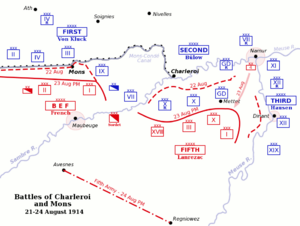
On August 19, the French Fifth Army moved into the area between the Meuse and Sambre rivers. They faced 18 German divisions with only 15 of their own. On August 21, the Germans attacked first. They captured bridges over the Sambre river.
The French tried to retake the bridges on August 22 but failed. The Germans also crossed the Meuse river. On August 23, the British army was attacked at Mons. With news of other French defeats, the French Fifth Army had to retreat. This was the final French move in the Battle of the Frontiers.
Battle of Mons
On August 23, the German 1st Army attacked the British Expeditionary Force (BEF) at Mons, Belgium. The Germans tried to cross the Mons–Condé Canal. The British fought bravely, using their rifles to stop the German advance.
The Germans eventually captured some bridges and pushed the British back. But the British defense was strong. They slowed down the German advance. The Germans thought they had only fought a small part of the BEF. They planned to surround the British the next day. However, the British managed to retreat, avoiding being trapped.
What Happened Next
The Great Retreat
After the battles on the frontiers, the French and British armies had to retreat. This was called the Great Retreat. From August 24 to September 5, they fell back across northern France. The Germans chased them closely.
Many towns were captured by the Germans during this time. The British fought another battle at Le Cateau to slow the Germans down. French troops also launched a counter-attack at the Battle of St Quentin. By September 5, the British retreat ended. The Germans were very close to Paris.
First Battle of the Marne
General Joffre used railways to move French troops from the eastern border to the west. This helped form a new French Sixth Army. By September 10, the French and British had more divisions than the Germans in the west.
On September 4, Joffre ordered a counter-attack. The Sixth Army attacked east of Paris. The British army also advanced. The French Fifth Army attacked north. This created a gap between the German 1st and 2nd armies. The German commander, Alexander von Kluck, had to move his troops.
By September 8, the French and British were pushing the Germans back. On September 9, the German 1st and 2nd armies began to retreat. The French and British followed them. By September 12, the Germans dug in north of the Aisne river. This marked the end of the Great Retreat. It also started a new phase of the war, where both sides tried to outflank each other, leading to the "Race to the Sea".
Casualties
The Battle of the Frontiers was very costly. From August 5 to September 5, 1914, France had about 329,000 soldiers killed, wounded, or missing. About 75,000 French soldiers died in August alone. A huge number, 27,000, were killed on August 22.
British casualties in August and September were around 29,598. German casualties were also very high. For example, the German 6th Army had over 34,000 casualties in August. The 7th Army had over 32,000. These numbers show how intense and deadly the fighting was at the very start of the war.



